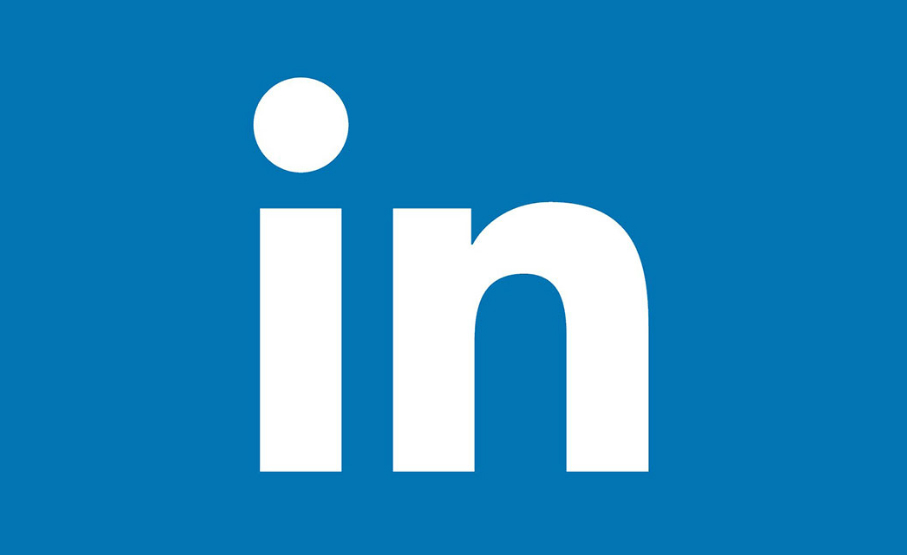
As far as major social networks go, LinkedIn is one that tends to find itself on the backburner for many people. This is understandable as it is the only professionally-focused network of the big players, and not everyone is interested in spending time dealing with their work life outside of work itself.
However, whether you like it or loathe it, LinkedIn is still an important social network for businesses and any professional who wants to build themselves and grow their base of professional connections.
In this blog, I will provide a look at the fundamentals of LinkedIn, both in terms of organic and paid options available to users and businesses, and whether or not the platform is a viable option for closing deals and making sales.
• Profiles and business pages
• Engaging organically on the network
◦ Making connections
◦ Posts and articles
• Paid engagement
◦ Boosted posts and ads
◦ Sponsored messages
• Can you sell on LinkedIn?
Profiles and business pages
Not much time needs to be spent on this part of the discussion, but profiles and business pages are, in many ways, the core foundations of LinkedIn.
Profiles
Unlike Facebook, where personal profiles are more about connecting with friends and family, profiles in LinkedIn essentially double as digital resumes for their users.
This is reinforced by the fact that many job search websites, such as Indeed, allow you to link your LinkedIn account so that your work and education history is automatically included in job applications.
As you’d expect, LinkedIn’s own job search function includes numerous job listings that allow for a “LinkedIn Easy Apply.” This option is essentially a one-click solution for applying for a job via the network.
Business pages
You can set up a business page that allows you to provide exact details of what your business does, its history, number of employees, and so on.
These pages allow you to post the kind of content you’ve come to expect: general text posts, videos (either directly or via linking to sites such as YouTube or Vimeo), questions, pictures, and so on.
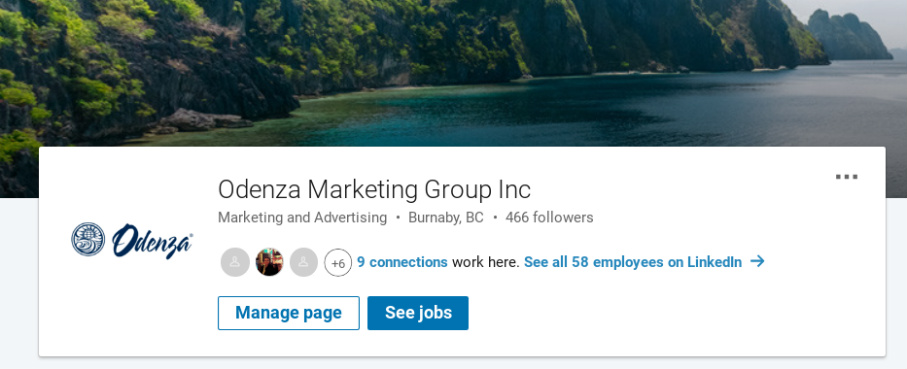
Engaging on LinkedIn
When it comes to LinkedIn and engagement, there are unique factors that must be acknowledged. First of all, remember that LinkedIn is a professional network. You can be lively and honest, but you still need to remember what LinkedIn is about.
Engagement comes in free and paid varieties as is the norm on social media. Let’s focus on the free (aka organic) options first.
Organic engagement
Making connections
Along with being a great way to have a consistent, up-to-date digital resume, LinkedIn’s other key purpose is networking.
Members build professional connections online much in the same way they would at a face-to-face networking event. You can share contact details, your business, what you do, and more – all without having to pay $50 for the event ticket.
Because it’s about networking, you don’t have to just stick to co-workers or friends. Branch out and see who else is out there that has mutual connections.
That said, it’s best to not reach out someone if it’s reasonable they’ll have no idea as to why you’re trying to connect. If this is a concern of yours, but you would still like to connect, include a note in your connection request that explains exactly why you want to.
Another quick piece of advice: as soon as you do connect to someone new, don’t immediately send them a message with some sales pitch. It’s an almost sure-fire way to have them remove you from their connections faster than they added you.
Articles
For the individual LinkedIn member, posts and articles are the two forms of content creation made available to them. Articles, however, are exclusive to members – business pages cannot post native articles on LinkedIn.
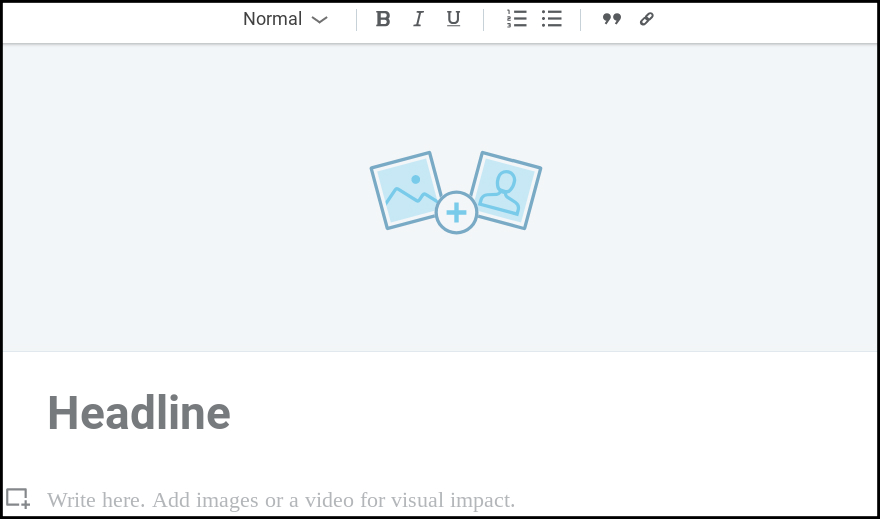
Writing an article utilizes a simple and intuitive WYSIWYG (“what you see is what you get”) article editor, which allows any LinkedIn member to write up long-form pieces that provide insight and tips for other members.
Depending on what your personal goal on LinkedIn is, such as becoming a thought leader, being able to write up and publish articles within the platform is a fantastic perk. Publishing in-depth, thoughtful articles for your connections and others to consider is a powerful way to build your reputation.
Paid options
On the paid options front, you have several options available as both a business and individual. These options, for the most part, are designed to help you better your chances of driving engagement, click-throughs, generating leads, and closing sales/offers.
These options come in the form of boosted posts, ads, and sponsored messages.
Boosting posts
On LinkedIn, boosted posts serve a very similar purpose as to what boosted posts on Facebook do.
When posting a new update on your business page, you have the option to put some extra money behind it so that it reaches more members. You select your target audience as you go and choose whether you want to pay per click (PPC) or per 1,000 impressions.
PPC is a good option when the post you’re boosting includes a link to a landing page where you could secure leads, whereas per impression is often more ideal if you simply want the post ending up in front of more eyes.
Ads
Ads differ from boosted posts in that you design them from the ground up are placed at the top and right-hand side of different pages on LinkedIn.
Ads can be purely text-based, include a small image with a headline and accompanying text, or exclusively be an image or animation. Below are screenshots of all such examples.

Text-only, top of page.

Small image, headline and text, side of page.
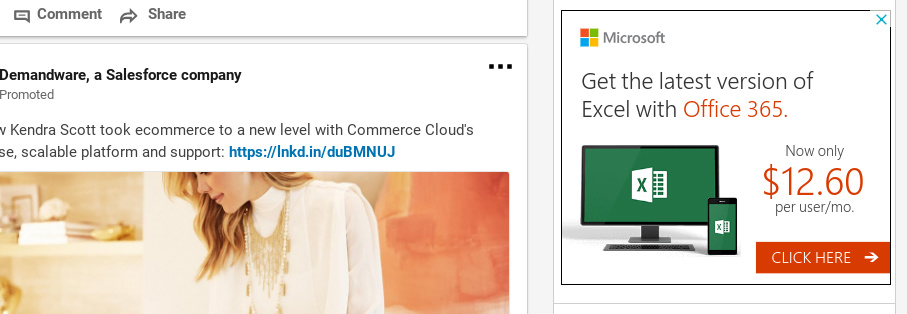
Larger image or animation, side of page
Sponsored messages
One other form of advertising, which deserves a standalone section, is sponsored messages – or, as LinkedIn likes to call it, Sponsored InMail. This option allows you to send personalized messages to your target audience directly through their InMail inbox.
These ads can show up to other members as though they were sent by you or your business.
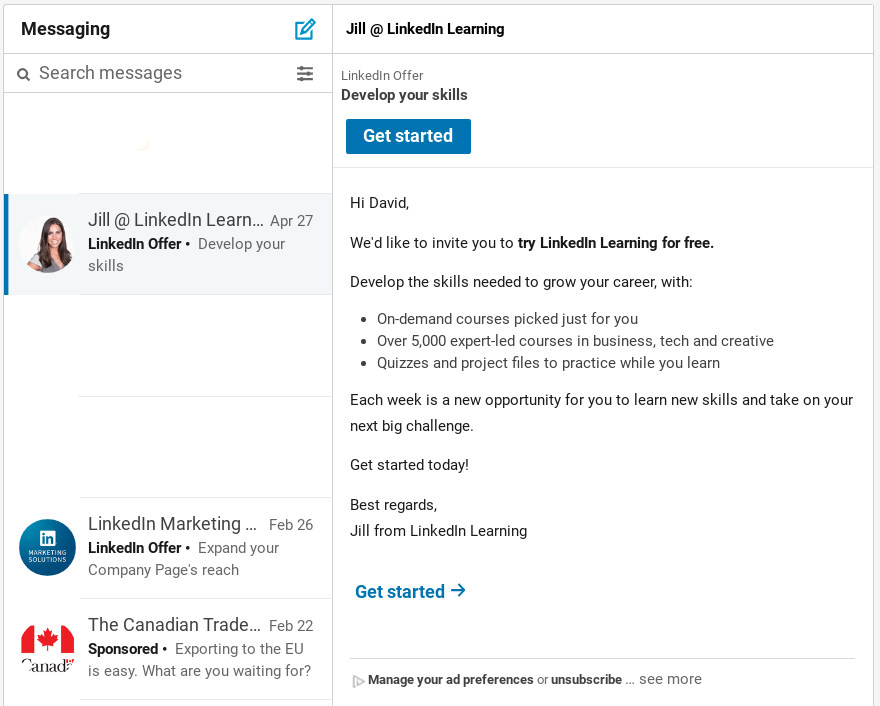
Can you actually sell on LinkedIn?
With all the organic and paid options available to members and businesses, the question of whether you can actually make a sale is an important one. First off, if you’re a B2B company, then your potential to generate leads and close sales on LinkedIn is greater than a B2C company.
After all, we’re talking about a network that is made for professionals – business owners, job seekers, entrepreneurs, etc. – so the key focus here is, “How can I further myself, my business, my career,” and B2B caters to this.
Travel incentives can work on LinkedIn for a wide range of B2Bs including, but not limited, to: recruitment agencies, consultation companies, accounting firms, advertising agencies, and more. If a company takes you on for your services, you reward them with travel/event certificates – and this is an offer that is ideal for promoting on LinkedIn, both organically and through paid means.
As I have mentioned in previous articles, travel and events (e.g. concerts, sporting events, shows) have a broad appeal. No matter the individual, travel and event-based incentives will cater to a recreational interest of theirs.
Incentivize them to try you out
Another approach to consider, which a range of B2B and B2C companies have done on LinkedIn, is to incentivize other network members to try out the products or services of your business. An example would be to offer sports and event tickets to any company or individual who demos your software, rents out your hardware (e.g. work computers) or work vehicles, attends a product demonstration hosted by you, etc.
While rewarding another business or individual for merely trialing your products/services won’t always result in a final sale, it’s an effective tactic on a professional network such as LinkedIn. After all, most businesses want to invest in what will lead to the very best ROI for them. Instead of the hard sell, you can reward them for considering you – and they don’t have to fear being locked into some problematic contract.
Once the incentive has done its magic, you take that opportunity to prove to them why your company is worth their money…
So, can you sell on LinkedIn? Yes, absolutely, but it heavily depends on what it is you’re offering and how that offer stands out to the professionally-driven individual.
Let’s Talk
Want to know how travel incentives can heightened your LinkedIn and other social media contest strategies? Then give us a call on 1-866-883-2968 or fill out the form below.
